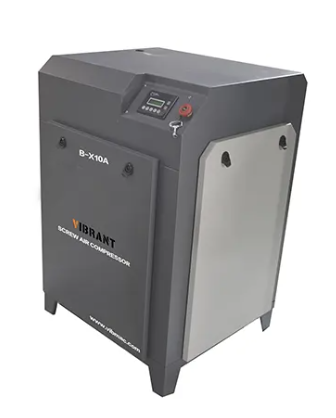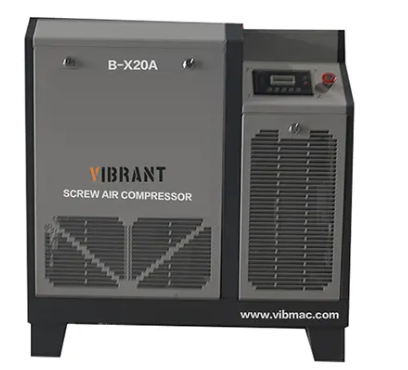Introduction
A belt driven rotary air compressor relies on a belt-and-pulley system that links an electric motor to the rotary screw air end. That air end houses two interlocking screws that rotate together, steadily squeezing incoming air into a high-pressure stream. Because the motor is not rigidly attached to the air end, engineers can easily adjust the belt tension to alter running speed and handle different load demands. By contrast, direct-drive compressors give no such latitude since the motor shaft connects straight to the screw assembly.
Vibrant Best Portable Rotary Screw Air Compressor
The Portable Rotary Screw Air Compressor pairs easy mobility with industrial toughness, making it ideal for remote job sites, construction crews, oil and gas fields, or off-grid workshops. Whenever and wherever you fire it up, the unit supplies a steady flow of high-pressure air without producing the pressure fluctuations common in piston models.
Advanced rotary screw internals deliver uninterrupted air service-no pulsing, no overheating, and no drop in efficiency at peak workloads. From running pneumatic tools to powering repair functions in the most isolated locations, this compressor stands ready to meet the demands of professional users who cannot afford downtime.
Key Product Feature
Compact & Portable Design
Engineered with a slim chassis, the compressor slips easily from one job site to the next. Integrated carry handles and optional all-terrain wheels permit smooth movement, while the unit’s reduced footprint fits comfortably into stairwells, sheds, or any cramped corner.

Continuous Airflow with Rotary Screw Technology
The rotary-screw pump replaces the usual piston set-up, so air flows steadily and quietly with little pulsation. Tools vibrate less, last longer, and perform better, making this system the first choice for 0sandblasting painting, or any heavy-duty pneumatic task.
Energy Efficient Operation
Every aspect of the design promotes fuel economy. The machine delivers ample air at lower consumption, trimming long-term costs. Even after hours of work, temperatures stay cool and performance steady.
Durable Construction for Harsh Environments
A tough outer shell and sealed compartments shield vital parts from dust, moisture, and impact. Built for the long haul, this unit thrives in construction sites, mines, oil fields, and other punishing settings.
Application Industries
This portable air compressor is ideal for use in:
Building and Construction
Powering jackhammers, nail guns, drills, and other pneumatic tools directly on-site.
Industrial Equipment Maintenance
This compressor is commonly found at tool-repair desks, factory workrooms, and service trailers alike.
Oil and Gas Fields
It supplies reliable compressed air for pipeline upkeep as well as for drilling rigs.
Belt Connection System
The machine employs a classic belt-drive arrangement, a design that has proved sturdy and adaptable over decades. Its multi-belt layout spreads load uniformly, thus boosting both efficiency and operator safety. Swap tasks are quick because the belts detach easily, so service time stays short.
Industrial Frequency Motor
A constant-speed industrial motor runs the unit, keeping RPM steady throughout every job. That steadiness cuts down on strain for both belts and motors, which in turn lengthens the whole assembly life. Spare parts are common, so upkeep stays straightforward and budgets remain under control.

Integrated Tank – Fully Movable
An onboard air vessel means users do not have to buy or store a bulky external tank, saving cash and workshop space. The tank and compressor are packaged in a single compact, easy-to-move enclosure that guards both equipment and crew. Such portability makes the unit fit nicely into cramped bays or onto service trucks.
How Does It Work?
Its basic action relies on positive displacement. The process unfolds as follows:
1. Air Intake: Clean surrounding air is drawn in through a replaceable filter.
2. Compression: The twin-screw rotors spin together, squeezing the air and shrinking its volume.
3. Cooling: A small oil cooler or compact air cooler pulls heat away from the works.
4. Separation: An in-line oil separator strips out the lubricant mixed with the compressed air.
5. Storage/Delivery: Clean, dry air then moves into a storage tank or travels straight to the tools.
Advantages of a Belt-Driven Rotary Compressor
So, why pick a belt-driven model? These traits suit it perfectly for tough, round-the-clock work:
High Efficiency
The rotary-screw layout delivers constant flow with little pressure drop, which is great for demanding tasks.
Energy Savings
Locked with a variable-frequency drive or properly sized, the unit trims power bills noticeably.
Flexible Speed
Belt tension changes set new RPM without swapping motors, letting operators tune output to need.
Low Maintenance
With fewer parts that move, breakdowns are rare; oil changes, tension checks, and filter swaps keep it healthy.
Longer Lifespan
Belt isolation eases motor load, cuts vibration, and often adds years to the life of the compressor.
How to Choose the Right Compressor?
Before you put money down on a belt driven rotary air compressor, make sure the machine matches the job you really plan to do. Start by asking:
What are your CFM and PSI requirements?
Air-hungry tools such as sandblasters and large paint guns demand high airflow (CFM), whereas impact wrenches prefer steady pressure (PSI). Check the spec plates on your equipment before anything else.
What power supply do you have?
In a home garage or small shop, a single-phase unit usually suffices; in a factory or big bay, a three-phase system runs cooler and lasts longer.
How big should the tank be?
A hefty tank holds reserve air, smooths output during extended use, and reduces the number of restarts cycles the compressor must endure.
What about noise levels?
When your workshop is set inside a home or near an office, a quiet, low-decibel model spares everyone the drone of heavy machinery.
Do you need portability?
For job sites a wheeled or skid-mounted compressor gets you moving; for a fixed bay, select a stationary unit that still gives easy access during routine upkeep.
conclusion
A belt driven rotary air compressor remains the backbone of any serious industrial facility. Its proven durability, operational versatility, and sensible cost structure make it a natural choice for workshops, factories, and production lines alike. Whether you require a 10-horsepower unit or intend to energize an entire network of pneumatic tools, a belt-driven model delivers unparalleled performance. Ready to elevate your operations? Visit VIBRANT today and discover the leading selection of air compressors.









